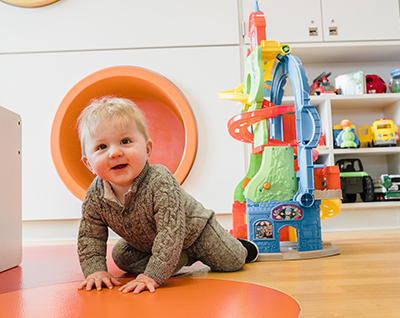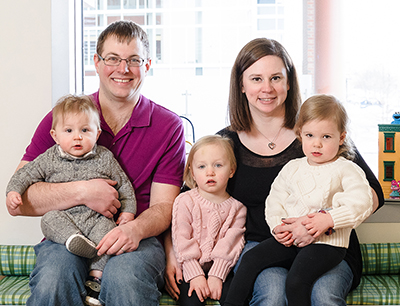Samuel Glaub
Groundbreaking New Treatment Transforms Baby’s Future
Catherine Glaub remembers exactly where she was — and what she was doing — when she got the phone call.
“I was at home, holding Samuel in my arms, and I went into the bedroom to answer the phone,” she said. “It’s just one of those moments that’s burned into your memory forever.”
Catherine and her husband, Jeffrey, had welcomed their new baby boy, Samuel, just a week earlier. He was born full term, weighing 8 pounds, 10 ounces — and so far, everything was going perfectly fine.
But when Catherine picked up the phone that day, a doctor told her that Samuel was not as healthy as he appeared: he had a rare, genetic disease, spinal muscular atrophy (SMA), type II. The diagnosis —discovered through genetic testing done at the hospital in Buffalo where Samuel was delivered — meant that Samuel would likely never walk: He’d spend his life in a wheelchair and would deal with medical issues for the rest of his life.
As Catherine hung up the phone, a million questions began running through her mind. Was
her son going to have a normal childhood? Would he ever be able to kick a ball or run through the front yard?
“I started shaking immediately,” said Catherine. “I was just in shock.”
A Turning Point
SMA is the number one genetic cause of death in infants. In infants with type 1 — the most severe form of the disease — symptoms start appearing within six months, as babies begin to gradually experience difficulty breathing, swallowing, and moving. Left untreated, most babies with the disease die by their second birthday.
Samuel was diagnosed with a less severe form of the disease, but was still expected to face a lifetime full of challenges. Children with type II are often in and out of the hospital with infections, struggle with maintaining their weight, and don’t meet physical milestones like sitting, crawling, and walking. Up until this past summer, treatment options for the disease were limited — and none were effective at truly halting the illness’ devastating symptoms.
“I have been giving this diagnosis for many years, and it has basically been a death sentence,” said Emma Ciafaloni, M.D., the director of the University of Rochester Medical Center’s Pediatric Neuromuscular Program. “The babies are cognitively intact, and it breaks your heart to look into their bright, inquisitive eyes and know what their future holds. I have had to tell many families that there is nothing we can do for them.”
But that all changed last year, when a new, groundbreaking treatment for SMA was approved by the Food and Drug Administration. The result of 50 years of research, the treatment is designed to replace the gene, SMN1, which is missing or not working in children with SMA. The therapy works by inserting a normal SMN1 gene into the AAV 9 virus empty shell. The virus delivers fully functioning copies of the SMN1 gene directly to the patient’s motor neuron cells in the spinal cord. These healthy genes then replicate and help re-establish muscle strength.
The treatment, marketed under the name Zolgensma, is the first in vivo gene replacement therapy. The clinical trials of the treatment showed transformative results: Babies who received the treatment as an experimental therapy have all survived beyond their second birthday, are talking, and have demonstrated improvement in their motor skills. Some children are now able to walk.
“I never thought I would see this in my lifetime,” said Ciafaloni. “It’s the perfect example of how bench research can truly impact families’ lives and make a difference. It’s completely re-energizing.”
Hope for Samuel

Samuel Glaub with his father, Jeffrey, mother, Catherine, and sisters Emma and Julie
The new treatment was approved by the FDA just five days before Samuel was born. Within just two days of Samuel’s diagnosis, the Glaubs were at URMC, the only location in the state offering the treatment.
“We knew this was the best hope for Samuel, and we knew the clinical studies showed great results,” said Catherine. “But it was scary. It was this brand new therapy, and we didn’t know what was going to happen.”
The team in Rochester had been preparing to deliver gene therapy for months, and had already given it twice under compassionate use provisions, which allow use of an experimental therapy prior to FDA approval.
“We are truly a leading edge center in our region,” said Debra Guntrum, a family nurse practitioner on the team. “We were ready to deliver this therapy before it was even approved, and it takes many resources to bring this therapy to the bedside safely and effectively.”
The Pediatric Neuromuscular Medicine Program, which cares for children with SMA, brings together neurologists, pediatricians, pulmonologists, nurses, physical and occupational therapists, social workers, genetic counselors, and orthopaedists to deliver care and support patients and their families. The team handles the complex process of delivering the new therapy, covering everything from bloodwork to complicated insurance approvals.
After a series of tests and appointments with the team, Samuel received the treatment when he was four-weeks-old. The therapy is administered through a one-time, 60-minute IV infusion in the Pediatric Treatment Center, known to many families as “AC-6.”
Samuel slept through the treatment and after a few hours of monitoring, he was sent home.
“There was no real way of knowing if it worked,” said Catherine. “Our only option was to wait and see.”
A New Future
 Today, Samuel is 10 months old. He’s crawling, smiling, and getting into everything — all the things a baby should be doing.
Today, Samuel is 10 months old. He’s crawling, smiling, and getting into everything — all the things a baby should be doing.
And he’s not showing any signs of the disease.
“He is doing beautifully,” said Ciafaloni, who sees Samuel on a monthly basis to check on his progress. “We don’t know what his future holds. But, unequivocally, his future is dramatically different than it would have been without this treatment.”
The team has now treated 10 babies with SMA through this gene therapy, all of whom have not had the typical progression of the disease. Families have come from the Adirondacks, Pennsylvania, and Syracuse to receive the treatment. In addition to offering the new therapy, URMC was also one of the first four institutions in the country to receive the Cure SMA Care Center Network designation, created to set new standards of care, expand access to novel treatments, and conduct clinical trials.
“We truly have it all here,” said Ciafaloni. “And I’m proud of that, because it’s been a true team effort and we’re able to have a real impact on families.”
The therapy, now FDA-approved for babies less than 2 years old, is more effective the sooner it is delivered. New York was one of the first five states to screen for SMA after birth, and now that an effective treatment has been identified, the focus is on expanding the genetic screening to all 50 states — so that all babies with the illness can be treated as soon as possible.
“This new therapy is really an example of when everything works right,” said Ciafaloni. “It makes me optimistic about what’s to come.”
The Glaubs, too, are confident about what the future will hold. While nothing is for certain, they feel fortunate that their son was born where and when he was — right at the cusp of a new beginning for children with SMA.
“Everything was on our side,” said Catherine. “How lucky are we?”